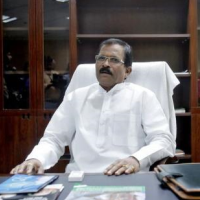Does India Need a Yoga Minister?
 Shripad Naik, Minister of AAYUSH (photo: Reuters)
Shripad Naik, Minister of AAYUSH (photo: Reuters)
When Prime Minister Narendra Modi was sworn in last May, he promised “minimum government, maximum governance”. But his first cabinet reshuffle last month belied this expectation, with his council of ministers expanded by 21 new members to a mammoth 66 ministers. These include one for the newly created ministry of AAYUSH (Ayurveda, Yoga, naturopathy, Unani, Siddha and Homeopathy). While yoga and traditional medicine could do with government support, does this justify creating a separate ministry of their own?
According to the Washington Post, the new minister Shripad Naik is spearheading efforts to promote and protect India’s most famous export by taking it to the masses.
In recent weeks, Indian officials have begun efforts to expand yoga into all facets of civic life – including more than 600,000 schools, and thousands of hospitals and police training centres. They are also considering to apply for a “geographical indication” for yoga, a trade protection normally given to region-specific goods such as Champagne from France or oranges from Florida.
“There is little doubt about yoga being an Indian art form,” Naik told the Washington Post. “We’re trying to establish to the world that it’s ours.”
Modi himself is pushing the effort. The prime minister reportedly rises at 5 a.m. daily for yoga stretches and deep breathing, and he credits his regimen with the ability to maintain a punishing work schedule.
"Yoga embodies unity of mind and body; thought and action; restraint and fulfilment; harmony between man and nature; a holistic approach to health and well-being," he told the United Nations General Assembly in September.
During his speech at the U.N. Modi proposed an International Yoga Day on June 21, an idea that has already found support from 130 countries, including the U.S. and China.
Although yoga has been a part of India’s heritage for centuries, the discipline bears little resemblance to the popular exercise regime that has become a multibillion-dollar industry in the West. Proponents like Bikram Choudhury, the founder of hot yoga who practices in Los Angeles, have even tried to copyright certain yoga series.
To protect India’s heritage, the Traditional Knowledge Digital Library has been building a compendium of age-old medicines and practices for more than a decade, making it available to patent offices worldwide. Archana Sharma, the project’s leader, told the Washington Post that they are documenting 1,500 yoga poses, some by videotape, which will be added online next year to help prevent the “misappropriation” of yoga by commercial enterprises.
Meanwhile, the government unveiled plans in November to set up a regulator for traditional drugs. India wants to expand its presence in the estimated $100 billion global market for alternative medicine.
Modi said recently that the country had missed the opportunity to market its industry of yoga and herbal medicine globally.
Ayurvedic and other types of traditional medicine, called unani and siddha, are popular in smaller towns, and homeopathy too finds wide acceptance. But critics often question the effectiveness of traditional remedies over modern medicine.
The renewed focus on yoga and traditional remedies is welcome, but it is debatable whether a separate minister is necessary for the AAYUSH department that earlier fell under the Health ministry.
According to Reuters, the success of the new ministry would depend on the funding provided. The government has allocated just $174 million to develop and promote traditional health systems in the current financial year.
- Karan Singh
To Learn More:
India’s new prime minister, Narendra Modi, aims to rebrand and promote yoga in India (by Annie Gowen, The Washington Post)
India gets minister for yoga and traditional medicine (by Aditya Kalra, Reuters)
- Top Stories
- Controversies
- Where is the Money Going?
- India and the World
- Appointments and Resignations
- Unusual News
- Latest News
- India College Chain’s Expansion into U.S. Draws Opposition from Massachusetts Officials over Quality of Education
- Milk Shortages in India Tied to Release of New Movies Featuring Nation’s Favorite Stars
- Confusion Swirls around Kashmir Newspaper Ban in Wake of Violent Street Protests
- Polio-Free for 5 Years, India Launches Vaccine Drive after Polio Strain Discovery
- New Aviation Policy Could Increase Service, Lower Ticket Prices






Comments